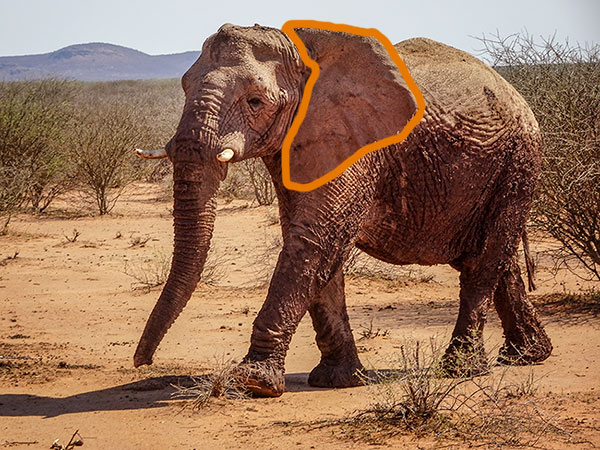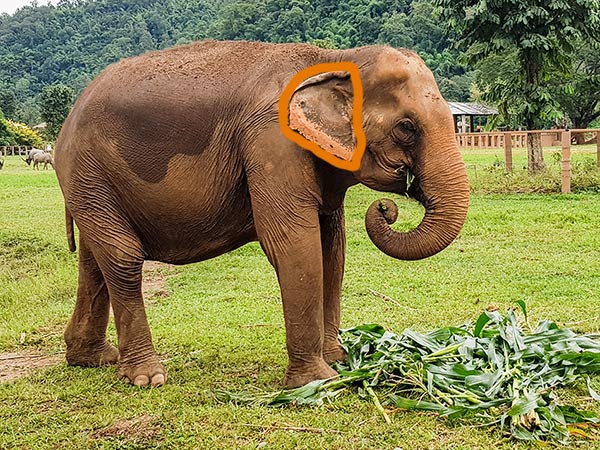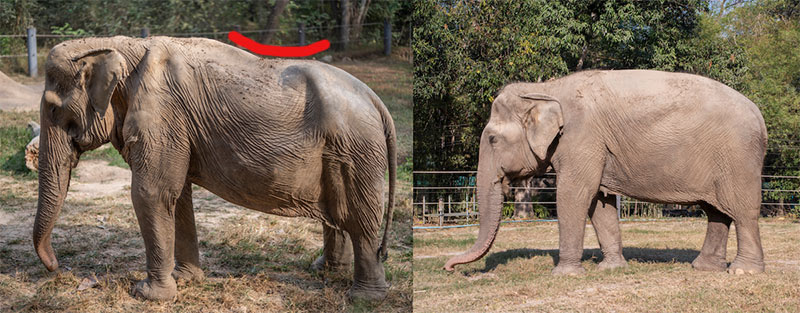It is very easy to distinguish between elephants. Like us humans, they have feelings and show them. But hearing with your feet is hard to imagine. Or who knows their air conditioning? Elephants as gardeners? And much more . . . let yourself be surprised
How do the different elephant species differ?
Elephants make up a family of proboscis. The biologist differentiates between 3 types of elephant, with 2 types of African elephant.

African elephant
large ears (up to 2m) - shape like AFRIKA
→ bull:
-
- about 3.20-4m high
- about 5-7.5t heavy
- Tusks up to 3m and up to 100kg in weight (grow in length and width for a lifetime)
→ cow:
-
- about 2.50m high
- about 2.8t heavy
- shorter tusks (grow slowly and only elongate after the age of 15)
Ears: large, up to 2m long – shape like Africa
Skin: wrinkled
Trunk: 2 gripper fingers
Forefeet: 4 toes
Hind feet: 3 toes
Move: Hollow back
Forehead: sloping
Habitat: Savannah, forest, desert
Nourishment: Leaf food
– Desert elephants (Mali, Gourma, Namibia) belong to the forest elephants
– Forest elephants (forests of Central Africa)

Asian Elephant
small ears - shape like INDIA
→ bull:
-
- about 2.7m high
- up to 5.4t in weight
- pronounced long tusks up to 3m + 100kg in weight and grow in length and width for a lifetime
→ cow:
-
- about 2.2m high
- up to 2.7t in weight
- Remnants or no tusks
Ears: – small – shape like India
Skin: more smooth, often pink spots
Trunk : 1 gripper finger
Forefeet: 5 toes
Hind feet: 4 toes
Move: Humpback
Forehead: 2 humps
Habitat: Forest, grasslands
Nourishment: grass
– Sri Lanka elephant (Sri Lanka)
– Sumatran elephant (Sumatra)
– Borneo pygmy elephant (smallest elephant in the north of Borneo)
– Indian elephant (Asian continent)
Are elephants gardeners?
Yes, the forest needs elephants and the elephants need forest. They find their food sources there and it serves as a habitat for the rearing of their young.
The pachyderms provide valuable services for the protection of forests and species.
Example: When the elephants uproot a tree, a hole is created in the jungle. Or, as can be seen in the photo on the left, the elephant partially felled the tree with the help of the lianas in order to get to the canopy and tore a large hole in the process. The ground plants receive sunlight and grow much faster.
Further information here in the source:
https://www.wiwo.de/technologie/green/tierische-gaertner-wie-elefanten-und-gorillas-waelder-schuetzen/13548734.html
Hear with your feet?
Yes – elephants hear with their forefeet and that over huge distances. The deep rumble tones (5 – 20 Hz) spread not only over the air, but also over the ground. Even though they are as loud as a truck, we humans cannot hear these sounds.
There are 2 types of hearing with your feet:
1. nerve cells in the sole of the foot pick up the vibrations and send them via nerves to the brain.
2. a wedge of fat in the foot picks up the vibrations and transmits them via the bones to the ears.
The sounds are broadcast at a speed of around 309m / s through the air and at 248-264m / s through the ground.
But watch out! Not all elephants can speak and understand each other, because there are different languages and dialects in the elephant kingdom.
Source: https://tierforscher.com/elefanten-hoeren-auch-mit-den-fuessen/

The skeleton of the elephant
The skeleton of the elephant consists of over 300 bones. Although the elephant is very heavy, it has amazing agility. So he can move forward and backward, swim and run. They can reach a decent pace and easily keep up with humans.
Elephants can stand still for a long time, consuming very little energy in the process. Sometimes they love to take a short nap standing up, but they also like to lay down sometimes. In total, they sleep between 2 to 6 hours within 24 hours.
Elephants, like us humans, have cartilage that points upward. Their discs have sharp bony protrusions that widen upward. The intervertebral discs and tissue thus protect the elephant’s back from above.
The spine can buckle as a result of constantly carrying heavy weight. The damage is irreparable. You can imagine how the gray giants suffer.
According to the Wildlife Friends Foundation Thailand (WFFT), these physical deformities are common in elephants used for tourist rides. WFFThat published the photos of Pai Lin and Thung Ngern to raise awareness of how much elephants can suffer in the equestrian industry.






